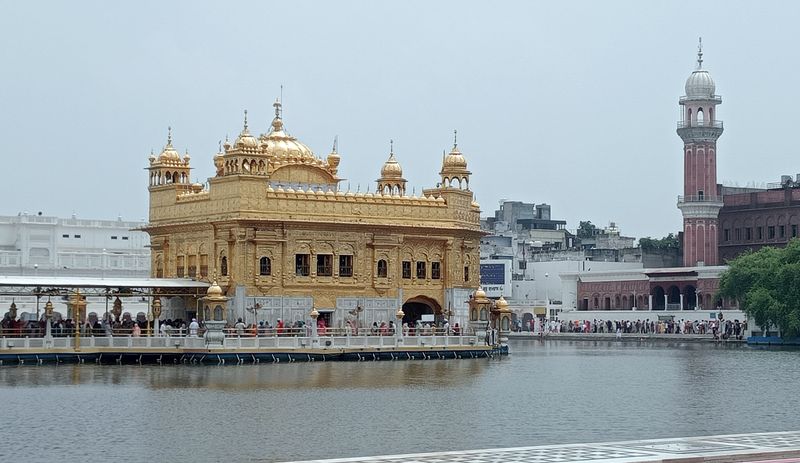The Local Government Department’s directions to regulate the construction of tall buildings around the Golden Temple are virtually an admission by the authorities that over the years, its surroundings have undergone a major change in a manner that needs urgent redressal.In violation of national and international norms governing the historical monuments, contemporary modern structures have come up, drastically changing the skyline around the 450-year-old Sikh shrine. The mismatch between the original and present character is reflected in a comparison between old paintings of the shrine and photographs of the present ones.The changing skylineOver the years, professionals engaged in development of the area around the Sikh shrine have apparently not bothered to refer to Chapter-12 of the National Commission on Urbanisation — 1988 report, which mentions certain guidelines for the maintenance of historical monuments.It categorically states that old cities were not designed for automobile traffic. However, over the years, massive damage to the traditional fabric of this historic walled city has been done by road widening and beautification schemes, such as the approach road project, elevated road project, corridor plan and the Golden Temple entrance plaza.Going a step ahead, a spatial conservation planner, Dr Balvinder Singh, former head of Guru Ram Das School of Planning, Guru Nanak Dev University (GNDU), said numerous commercial structures have come up around the Golden Temple, which have altered its skyline forever. The area was once home to rich Sikh architecture. However, incongruous interventions have altered the surroundings of Darbar Sahib.Citing an “incongruous skyline” near the Golden Temple complex, an overhead water tank was demolished several years ago. Later the authorities, however, lowered their watch and several new buildings, including glass structures, came up defeating the purpose of the entire exercise.Recently, Local Bodies Minister Dr Ravjot Singh, in a communiqué mentioned about the buildings which are disturbing the skyline of the walled city in general and the Golden Temple area in particular. Construction of these structures should be reviewed as per the already laid down bylaws of this specific area. If there is any violation of the bylaws, then strict action will be taken against the violators. He also demanded an action taken report in the matter within a week.Conservationists are of the opinion that the directions came too late as contemporary modern structures have already come up in the narrow winding bylanes of the walled city. They believe that the bylaws for the walled city, which also included surroundings of the Golden Temple complex, should be reviewed. They did not appreciate the change in land use from residential to commercial.While enough damage has already been done, still many areas like Katra Ahluwalia, Chowk Baba Sahib, Bazar Kesarya, Pratap Bazar, the area around Baba Attal retain their original character. The area around the holiest Sikh shrine is characterised by open spaces and traditional wells, all features which are visible in any city which has its origin in middle or ancient history.Changes over the agesThe holy city has seen various ups and downs in its physical growth during its history. Initially, it was the victim of Mughal rulers, but the Sikh Misls period from 1765 to 1802 is considered to have been favourable for its development. Many areas still retain the memory of the Sikh Misls, who were instrumental in setting up several Katras.Several areas in the walled city continue to be popular from Misl names like Katra Dal Singh, Katra Charat Singh, Qila Bhangiya and Qila Ahluwalia. During the period, various Akharas (Centres of learning), Bungas (rest houses), Havelis (house with courtyard), Forts and Gardens were developed. Notably, the names of localities with Baghs like Bagh Ramanand, havelis and Qila continue to be popular in common parlance but these structures are no longer visible due to rampant commercialisation and ignoring history.The period of legendary Sikh Maharaja Ranjit Singh from 1802-49 is considered the golden period for the physical development of the holy city. It was during this period that a wall around the city with 12 gates was constructed, a fort in the name of Guru Gobind Singh was strengthened and a beautiful garden based on the Shalimar Bagh, Lahore, was created in the name of Guru Ramdas, the founder of the city.Decorative and architectural elements in the form of frescoes and other ornamental elements were then added, but these are now barely visible in its walled part. It was during this period that Sri Harmandir Sahib was decorated with frescoes and other art forms, such as tukri, inlaid stone, mohrakashi, gold embossing etc.During the colonial rule, the British altered the historic Rambagh’s layout and many incongruous additions were made in the Gobind Garh Fort, thereby destroying its originality. Major portions of the wall and gates were demolished and the moat was filled up. To quote Prof PC Khanna in his paper ‘The Ram Bagh — The splendour It Was’: “It is rather unfortunate that the well-knit place of civic design created by the Maharaja, like his dynasty, was soon destroyed after his death, through the vandalism of petty bureaucracy and unimaginative military, engineers and surveyors of British. To begin with, it was renamed, after the East India Company, to Company Bagh. They tried to superimpose their own design in Ram Bagh. The garden at present is thus a hotchpotch of formal and informal styles”.The next period from 1947 to 2006 was the worst period for this city. It was badly affected by the partition of the country in 1947. Due to riots, about 30 per cent of the areas in the walled city were burnt and replaced with new localities and structures.Appreciating the government’s direction to regulate the construction of tall buildings around the Golden Temple, now conservationists want it to devise a plan to preserve the old structures symbolic of Sikh and other medieval architecture.
next post


